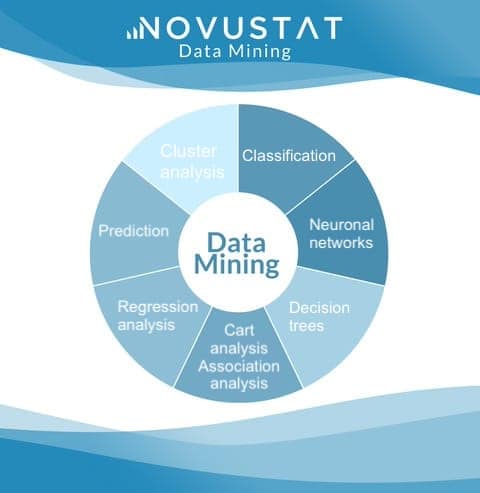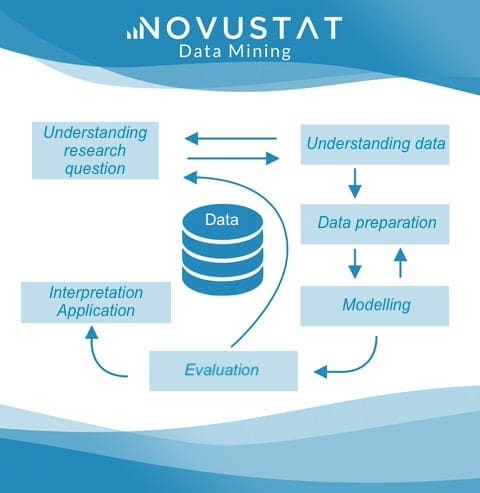Data mining is also known as intelligent data analysis. In data mining consulting, we identify patterns and rules for you in large volumes of data using statistical methods, artificial intelligence (e.g. neural networks) and visualization techniques. This involves not only analyzing data from the past, but also making predictions for the future.
Which experience did our customers make with Novustat
Our data mining service in detail
We are happy to support you with the following services:
- Data mining consulting: We support you in all phases of planning and implementing your specific data mining project.
- Predictive modeling: We create forecasts based on the data mining results. A target-oriented approach requires a high level of expertise and goes far beyond simple extrapolation into the future.
- Big data mining: To ensure that your data mining works efficiently even with large and complex data volumes, we help you to scale your processes.
- Data Mining Deployment: Data mining serves not only to increase knowledge, but above all for a practical purpose: the results obtained must be applied in a useful way, for example by segmenting customers into categories, or to provide a basis for an appropriate response to future developments. We will be happy to help you create and implement a successful concept.
- Visualization & processing: Data mining produces large quantities of results. We take care of their clear, descriptive and target group-oriented presentation.
If you need support with a data mining project, our statisticians will be happy to help you. Simply use our Contact form for a free consultation & a non-binding offer – or give us a call.
You are also welcome to watch our video about our support options on YouTube.
What is data mining?
Data mining is a generic term for processes that generate knowledge from data in order to make well-founded decisions. It is used in basic research as well as in market research, production optimization and healthcare. Wherever large amounts of data (big data) are generated.
These methods are more efficient than traditional statistical evaluations and can search for correlations between all data, discover clusters of somehow similar data sets and find temporal or geographical patterns. Efficient algorithms, data visualization methods and artificial intelligence are used for this purpose.
Typical questions in data mining
- What factors influence a customer’s decision to repay a loan?
- Which factors cause a certain disease or accelerate healing?
- Which product is a particular customer likely to buy?
- Predicting customer churn
Such knowledge supports the planning of marketing campaigns, forecasting, fraud detection, business intelligence and many other business activities.
Our services in the field of data mining consulting
- Advice on planning: What should be pursued with the data mining project? Is the goal achievable? In what time and with what effort? What are the prerequisites for this?
- Advice on data collection: Where can data be collected and how? What data mining methods are available? How should questions be formulated? Which key figures are suitable for answering a specific question?
- Advice on data protection issues: Which data may be analyzed for which purpose? How do you reliably anonymize data? We are happy to program your anonymization routine.
- Support with data preparation: We help you to merge your data and improve its quality, i.e. with provision, integration, migration and cleansing.
- Evaluation support: Novustat’s experts are familiar with all data mining methods and tools and will help you to set up and program the evaluations, check your code for errors or carry out a second evaluation to confirm your results.
- Interpretation and presentation of the results: We are also happy to help you interpret your results and present your findings in a target group-oriented manner for donors, customers, management or the public.
Why is consulting often necessary in the context of data mining?
The methods and procedures of classical statistics are not sufficient for data mining. New methods have been developed for this purpose, such as
- clustering,
- Classification,
- Crossvalidation,
- Decision tree
- the segmentation and
- the aggregation of data records
This is one of the reasons why most people need advice from specialized service providers when it comes to data mining.
While traditional statistical evaluations are often limited to two or three dimensions and examine, for example, correlations between two variables or differences between two groups of test subjects, the data and evaluations of data mining involve multidimensional problems.

Who is data mining consulting suitable for?
Our statistics consulting is universally designed and offers you qualified statistics help in any case. Our service is suitable for all interested parties, especially corporate customers, who want to deal individually with specific questions of data mining, regardless of the type of data:
- Place of residence: Only an Internet connection is required for our statistical consulting service
- Scientific or operational issues: we will find the right expert for your challenge!
- Prior knowledge: We pick you up and adapt to your needs
- Field of application: With our statistics experts, we can provide excellent support for financial, economic, biological, medical, psychological and marketing applications in particular and contribute our specialist knowledge in an application-oriented manner.
How is the consultation carried out?
The data mining consultation takes place online with screen transmission. We use Skype, Zoom or MS Teams for coaching. Alternative media can be used with corporate customers, for example, if the customer organizes the meeting. As part of a statistics consultation, our experts will advise you on your problem and show you possible solutions. An evaluation from our side does not take place in the context of a statistical consultation. This service can also be used separately.
If you need support in the form of data mining advice, our statisticians will be happy to help you. Simply use our Contact form for a free consultation & a non-binding offer – or give us a call.
Common data mining methods
Data mining involves not only the evaluation of data, but also its consolidation, data cleansing and other preparation. Data analysis is usually about answering a specific question. Exploratory data mining is also possible, in which hypotheses are generated from the data.
Procedures that are frequently used include:
Clustering
Clustering is about finding groups of data (so-called clusters). A cluster is a set of objects that are very similar to each other in terms of certain properties. A large number of cluster algorithms are available for this purpose. The difficulty lies in finding the variables and algorithms that fit the data and the question.
Classification
For the classification, the objects are categorized into classes based on criteria that match the question asked.
Segmentation
Segmentation is an appropriate classification of data. This expediency depends, of course, on the question asked. For example, customers can be segmented according to the frequency or size of their orders, their payment reliability, zip code, age, etc.
Extraction
During extraction, the data relevant to the question posed is selected from the entirety of the data. Depending on the type of data, linguistic methods for text data or self-learning methods (e.g. with neural networks) can also be useful here.
Dependency analyses (e.g. correlation analyses or regression)
Dependencies between two variables are calculated, e.g. between age and sales made. Do older customers buy more or less of a particular product?
Validation
Correlations found in the data should then be validated using other data. For this purpose, the available data is often divided into two groups from the outset: the training data and the test data. The training data is used to train neural networks, for example, and the test data is then used to check whether the learned algorithm works. This validation can prevent patterns that occur randomly in one part of the data from being falsely regarded as generally valid.
Tools in the context of the various data mining methods
The tools can also be divided into different categories according to the data mining methods:
- Statistical software supports the usual statistical methods such as regression and correlation analysis as well as multivariate analyses, e.g. mining with R or SPSS evaluation.
- Artificial intelligence enables pattern and rule recognition, especially machine learning software such as RapidMiner.
- Cluster analysis tools find clusters in the data.
- Language processing tools analyze natural language texts.
- Data visualization tools display data and its properties graphically.
You can find more information on these tool types and associated tools here.
The optimal data mining methods for your data
Of course, the data mining method and tools should be selected to suit your problem. We support you in selecting the best possible procedure or apply it on your behalf.
The phases
Data is explored iteratively. In other words, you feel your way towards the results. A distinction is made between the following phases, which can be repeated as often as required:

1. data selection and cleansing
In this step, the data to be analyzed is selected and incomplete or implausible data records are cleaned up and, if necessary, the data is converted into a different format.
2. data exploration
A systematic search is too time-consuming for large amounts of data. Therefore, heuristic search methods are used. This involves looking at the data from different perspectives in order to find concrete expectations confirmed and to be surprised by the results. Data exploration is supported by visualization tools that enable the visual representation of data and its properties in several dimensions, colors and shapes. Artificial intelligence methods can also reveal correlations that remain hidden to the human eye.
3. modeling in data mining
Exploration reveals patterns, connections and correlations between data. To determine whether the data relationships found actually exist and are statistically significant, the underlying assumptions and hypotheses are expressed mathematically.
4. evaluation
The hypotheses are then tested on the basis of the available data and other data using the usual statistical methods.
5th application
The patterns found are used, for example, to create forecasts or develop marketing strategies.
Where is data mining used?
Data mining can efficiently search through large amounts of data (e.g. big data) and not only find correlations that were already suspected, but also completely unexpected ones. This makes it the ideal method for unearthing data treasures that companies collect unintentionally or through website tracking in the course of their business activities.
Analysis of customer data
The regularly generated information includes customer master data and transaction data. This makes it possible to determine in which areas a particularly large or small number of customers live or which customer groups order how much and what, as well as reliably pay their bills. It is also possible to determine which products are bought most frequently, which products are bought most frequently by a customer group and so on. This allows customer categories to be formed and targeted advertising measures and discounts to be launched that only apply to individual market segments.
Process optimization
Other interesting data are those that arise during the production and quality assurance of products, for example: How long does it take to manufacture a product from delivery of the material to delivery to the customer? Which work step takes the longest? What is the throughput of which step and where is productivity limited by bottlenecks? Where is the most waste generated?
Optimization of websites
Tracking a website generates additional information about how visitors arrived at it, what interests them and what does not, which keywords they click on and which subpages they read most carefully. This provides companies with direct and unbiased feedback on the effectiveness of advertising measures and the attractiveness of website content.
Scientific studies
Although data mining is primarily associated with commercial applications, scientific studies can also benefit enormously from this process. Possible areas of application are the evaluation of radiation from space or data from a particle accelerator, patient data from a hospital or heart sounds from ECG recordings.
In fact, there are an infinite number of possible applications, so that any type of data can be structured and insights generated.
Data mining support from Novustat
We will be happy to help you with your project. All you need to do is formulate the question and we will take care of the rest. Alternatively, we can also support you as part of a consultation, where you can book support services individually or in full. Contact us and you will definitely find competent help every step of the way. Simply use our contact form for a free consultation & a non-binding quote – or give us a call.



 Professionality
Professionality